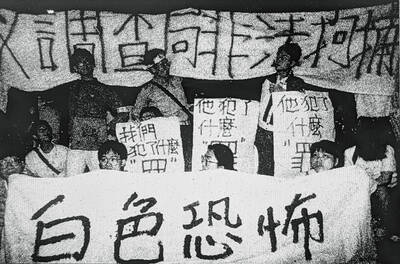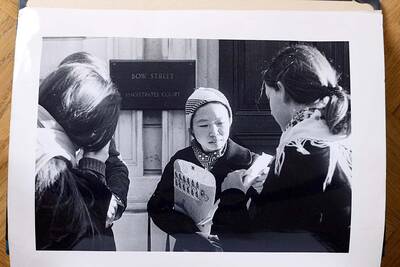Afounding figure of Taiwan New Wave cinema, director-cinematographer Chen Kun-ho (陳坤厚) begin his distinguished career by collaborating with Li Hsing (李行) and later Hou Hsiao-hsien (侯孝賢) in films such as The Story of a Small Town (小城故事, 1979), The Boys From Fengkuei (風櫃來的人, 1983) and A Summer at Grandpa’s (冬冬的假期, 1984). He started directing his own features in 1979 and made several important films including Growing Up (小畢的故事, 1983), His Matrimony (結婚, 1985) and Osmanthus Alley (桂花巷, 1987), before shifting to television production toward the end of 1980s.
Twenty years later, Chen returns to the director’s chair with Colorful Mind (孩子的天空), a sober story about the short life of a talented child and the latest big-screen adaptation of Hakka literary heavyweight Chung Chao-cheng’s (鍾肇政) 1960 novel Lupinghua (魯冰花).
Set during the 1970s, the film begins with art teacher Guo Yun-tien (Shown Chen, 陳至愷) arriving at an elementary school in the mountains. There, he meets Gu Aming (Wu Chun-kai, 吳浚愷), a fourth-grader in his class, and is immediately drawn to the boy’s unrestrained imagination and creativity.
Born into a poor family of tea growers, Gu loves to draw but often has to skip school to help his parents with their work. He never paints according to the lifelike color-scheme and proportions he has been taught, which for Guo is the mark of a truly talented artist.
The two quickly become friends, and the young art teacher promises to send Gu to a county painting contest. But the powers-that-be have other ideas, and Gu is replaced by an honor student from an influential family. Deeply frustrated with the establishment, Guo, who is leaving the school, asks another teacher, Lin Hsuan-fen (Chou Yu-ting, 周幼婷), to help enter Gu’s work in a international competition.
The news of Gu winning the top prize at the competition reaches the village. Sadly, the boy has contracted pneumonia and can’t even hear his friends cheering as he lies dying on a hospital bed.
For many older members of the audience, director Yang Li-kao’s (楊立國) 1989 adaptation Dull Ice Flower (魯冰花) is the definitive cinematic version of the tale and will forever be remembered for its heartrending plot. In Colorful Mind, director Chen spares contemporary audiences the tear-jerking moments, though he remains faithful to novelist Chung’s acute social commentary on the lives and hardships of the area’s farmers.
The world in the story is divided into two parts. In one, the landowners and local government have wealth and power to spare but are reluctant to help those in need. In the other, the poor tea farmers toil relentlessly to earn a meager living and cannot even afford to pay their children’s medical bills.
Stepping beyond Chung’s two worlds, Chen updates the former’s simple, straightforward tale with an emphasis on art education for children, and incorporates the real-life story of art teacher Wu Hung-tsang (吳鴻滄), who promoted art education in an elementary school in rural Tainan County.
Child actor Wu Chun-kai catches most of the attention with his natural onscreen manner and heartfelt laughter. But Shown Chen and Chou Yu-ting flounder in their roles as the two adults leads, and the villain, the director of the school, is a poorly designed character whose Beijing accent comes across as more confusing than anything else.
Colorful Mind is solid effort by a director after a 20-year-long hiatus from the cinema, but it fails to live up to the standard set by Chen’s 1980s oeuvre.

From the last quarter of 2001, research shows that real housing prices nearly tripled (before a 2012 law to enforce housing price registration, researchers tracked a few large real estate firms to estimate housing price behavior). Incomes have not kept pace, though this has not yet led to defaults. Instead, an increasing chunk of household income goes to mortgage payments. This suggests that even if incomes grow, the mortgage squeeze will still make voters feel like their paychecks won’t stretch to cover expenses. The housing price rises in the last two decades are now driving higher rents. The rental market

July 21 to July 27 If the “Taiwan Independence Association” (TIA) incident had happened four years earlier, it probably wouldn’t have caused much of an uproar. But the arrest of four young suspected independence activists in the early hours of May 9, 1991, sparked outrage, with many denouncing it as a return to the White Terror — a time when anyone could be detained for suspected seditious activity. Not only had martial law been lifted in 1987, just days earlier on May 1, the government had abolished the Temporary Provisions Effective During the Period of National Mobilization for Suppression of the Communist

Fifty-five years ago, a .25-caliber Beretta fired in the revolving door of New York’s Plaza Hotel set Taiwan on an unexpected path to democracy. As Chinese military incursions intensify today, a new documentary, When the Spring Rain Falls (春雨424), revisits that 1970 assassination attempt on then-vice premier Chiang Ching-kuo (蔣經國). Director Sylvia Feng (馮賢賢) raises the question Taiwan faces under existential threat: “How do we safeguard our fragile democracy and precious freedom?” ASSASSINATION After its retreat to Taiwan in 1949, the Chinese Nationalist Party (KMT) regime under Chiang Kai-shek (蔣介石) imposed a ruthless military rule, crushing democratic aspirations and kidnapping dissidents from

Fundamentally, this Saturday’s recall vote on 24 Chinese Nationalist Party (KMT) lawmakers is a democratic battle of wills between hardcore supporters of Taiwan sovereignty and the KMT incumbents’ core supporters. The recall campaigners have a key asset: clarity of purpose. Stripped to the core, their mission is to defend Taiwan’s sovereignty and democracy from the Chinese Communist Party (CCP). They understand a basic truth, the CCP is — in their own words — at war with Taiwan and Western democracies. Their “unrestricted warfare” campaign to undermine and destroy Taiwan from within is explicit, while simultaneously conducting rehearsals almost daily for invasion,